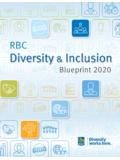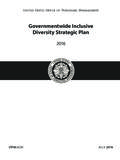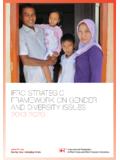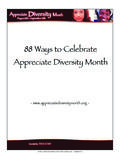Transcription of Minimum Dietary Diversity for Women- A Guide to …
1 FANTAIIIFOOD AND NUTRITIONTECHNICAL A SSISTANCEM inimum Dietary Diversity for WomenA Guide to MeasurementMinimum Dietary Diversity for WomenA Guide to MeasurementPublished bythe Food and Agriculture Organization of the United NationsandUSAID s Food and Nutrition Technical Assistance III Project (FANTA), managed by FHI 360 Rome, 2016 Recommended citation: FAO and FHI 360. 2016. Minimum Dietary Diversity for Women: A Guide for Measurement. Rome: designations employed and the presentation of material in this information product do not imply the expression of any opinion whatsoever on the part of the Food and Agriculture Organization of the United Nations (FAO), or of FANTA/FHI 360 concerning the legal or development status of any country, territory, city or area or of its authorities, or concerning the delimitation of its frontiers or boundaries.
2 The mention of specific companies or products of manufacturers, whether or not these have been patented, does not imply that these have been endorsed or recommended by FAO, or FHI 360 in preference to others of a similar nature that are not funding for this publication was made possible by the generous support of the American people through the support of the Office of Health, Infectious Diseases, and Nutrition, Bureau for Global Health, Agency for International Development (USAID), under terms of Cooperative Agreement AID-OAA-A-12-00005 through the Food and Nutrition Technical Assistance III Project (FANTA), managed by FHI views expressed in this information product are those of the author(s) and do not necessarily reflect the views or policies of FAO, FHI 360, UC Davis, USAID or the encourages the use, reproduction and dissemination of material in this information product.
3 Except where otherwise indicated, material may be copied, downloaded and printed for private study, research and teaching purposes, or for use in non-commercial products or services, provided that appropriate acknowledgement of FAO as the source and copyright holder is given and that FAO s endorsement of users views, products or services is not implied in any requests for translation and adaptation rights, and for resale and other commercial use rights should be made via or addressed to information products are available on the FAO website ( ) and can be purchased through FAO, 2016 ISBN 978-92-5-109153-1 (FAO)Contents Acknowledgements.
4 IAbbreviations and acronyms ..iiQuick Start Guide ..ivSection 1. Introduction ..1 Section 2. Description of food groups ..9 Section 3. Model questionnaire ..23 Section 4. Preparing the MDD-W questionnaire ..27 Section 5. Selection and training of enumerators ..33 Section 6. Tabulation, presentation and interpretation ..37 References ..43 Appendix 1. Sampling and design issues specific to measurement of Minimum Dietary Diversity for Women of Reproductive Age ..45 Appendix 2. Guidance on assigning individual foods to food groups for Minimum Dietary Diversity for Women of Reproductive Age.
5 47 Appendix 3. Alternative method for collecting information on food groups consumed the list-based method ..66 Appendix 4. Comparing Minimum Dietary Diversity for Women of Reproductive Age and Infant and Young Child Feeding Minimum Dietary Diversity ..70 Minimum Dietary Diversity for Women A Guide to MeasurementAcknowledgementsThis document reflects many contributions. The writing team was led by Mary Arimond1 and Terri Ballard2, and included Megan Deitchler3, Gina Kennedy4 and Yves Martin-Pr vel5. The authors are very grateful to participants at a July 2014 consensus meeting and a January 2015 technical meeting who shared field experiences and provided many insights that are reflected herein.
6 See for the meeting report from July 2014 and for the lists of participants at both meetings. Previous versions of this document were reviewed by Elodie Becquey, Marie-Claude Dop, Leslie Koo, Claudia Lazarte Pardo, Warren Lee, Mary Lung aho, Judiann McNulty, Theodora Mouratidou, Mourad Moursi and Anne Swindale; the authors are very grateful for the reviewers many insightful comments. Pauline Allemand, Kiersten Johnson and Jef Leroy also made contributions on key points. Development of this document was funded by the Agency for International Development (USAID) through the Food and Nutrition Technical Assistance III Project (FANTA), the Food and Agriculture Organization of the United Nations (FAO) and the World Food Center at the University of California, Davis.
7 Finally, the authors are very grateful to members of the Women s Dietary Diversity Project (WDDP), a long-running collaboration whose members, in addition to the five-member writing team, include Pauline Allemand, Elodie Becquey, Alicia Carriquiry, Melissa Daniels, Marie-Claude Dop, Elaine Ferguson, Nadia Fanou-Fogny, Maria Joseph-King, Warren Lee, Mourad Moursi, Marie Ruel, Liv Elin Torheim and Doris Wiesmann. WDDP members have shared thoughts and experiences for many years and these too are reflected within. However, the writing team is responsible for the content and any Program in International and Community Nutrition, University of California, Davis2 Food and Agriculture Organization of the United Nations3 FANTA/FHI 3604 Bioversity International5 Nutripass Research Unit.
8 Institut de Recherche pour le D veloppementiMinimum Dietary Diversity for Women A Guide to MeasurementAbbreviations and acronymsCAPI Computer-Assisted Personal InterviewingFAO Food and Agriculture Organization of the United NationsFBDG Food-based Dietary guidelinesFCS Food Consumption ScoreHDDS Household Dietary Diversity ScoreIYCF Infant and young child feedingMDD Minimum Dietary DiversityMDD-W Minimum Dietary Diversity for Women of Reproductive AgeMSG Monosodium glutamateNRV Nutrient Reference ValueRE Retinol equivalentsRAE Retinol activity equivalents UHT Ultra-high temperatureUSAID Agency for International DevelopmentWDDS Women s Dietary Diversity ScoreWFP World Food ProgrammeWHO World Health OrganizationWRA Women of reproductive ageiiiiiQ U I C K S TA R TMeasuring women s Dietary Diversity Quick Start GuideThis Quick Start Guide provides hyperlinks to guidance on specific questions and tasks and also a cautionary list of common errors (see box below).
9 All users should read the Quick Start Guide for an overview of available guidance and common pitfalls. We encourage users with no prior experience with simple food group Diversity indicators to consider reading the full manual. Experienced users may find this page useful for quickly finding answers to specific questions. Please also see the Frequently Asked Questions. Why measure Minimum Dietary Diversity for Women of Reproductive Age (MDD-W)? Indicator definition Appropriate uses of the MDD-W indicator Comparison with other food group Diversity indicators (see also Appendix 4) How to collect data introducing the guided open recall Survey sampling and design issues for food group recalls Brief descriptions of the ten MDD-W food groups Detailed food lists for the food groups Problem foods that are difficult to classify Model questionnaires to be adapted.
10 Open recall and list based method Translating and adapting the questionnaire Choosing and training enumerators Example of instructions for enumerators Tabulating the MDD-W indicator Recommendations for presenting MDD-W resultsiv and the .COMMON PITFALLS .Improper uses of MDD-W Do not use to assess diet quality of individual women. Do not use as a basis for developing Dietary guidance; use standard best practices from the World Health Organization (WHO)Food and Agriculture Organization of the United Nations (FAO) Do not use to develop behaviour change messages; use standard best practices, for example, toolkits found from Alive & Thrive, The CHANGE Project, The C-Change Project, and or incorrect preparation of questionnaires If you cannot afford to adapt a model questionnaire to your context, reconsider collecting data for this indicator.















